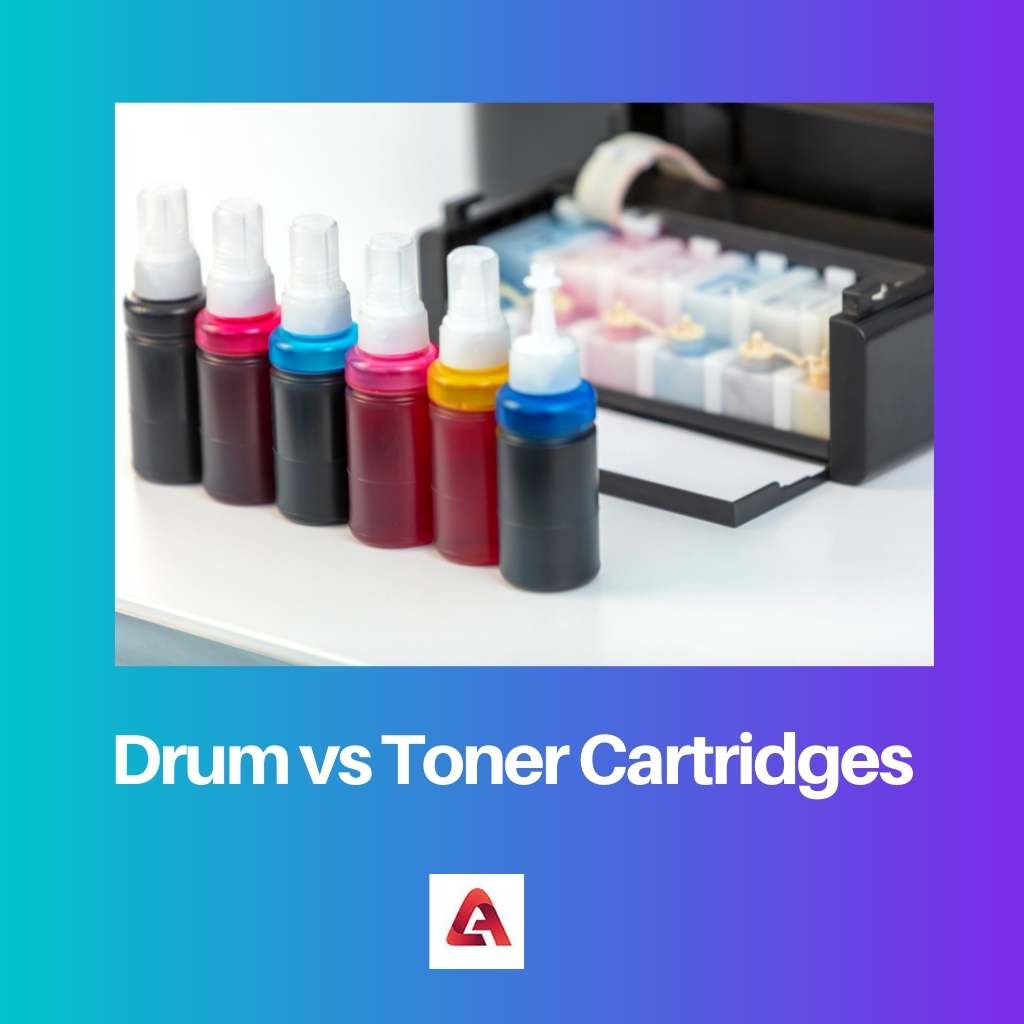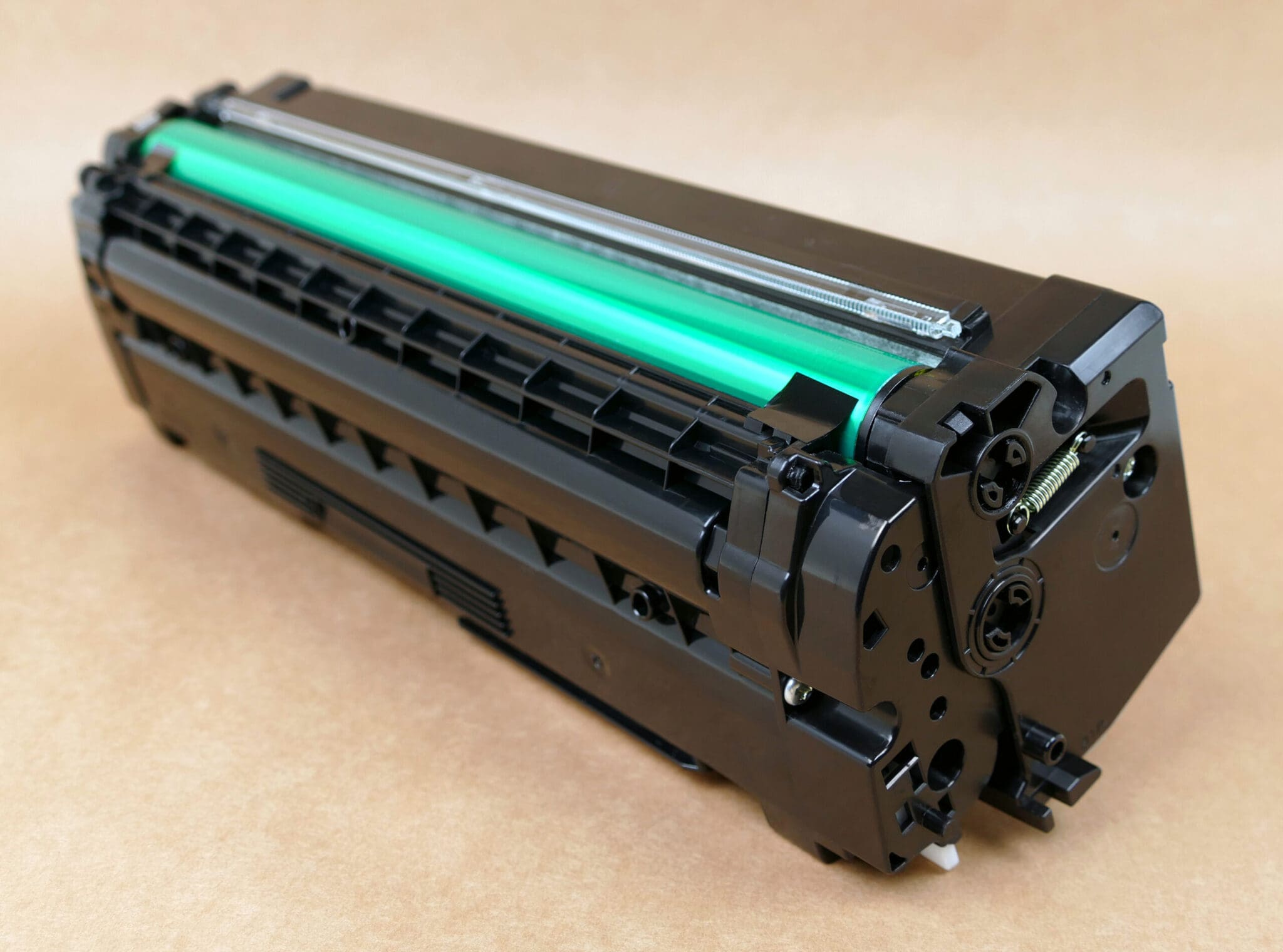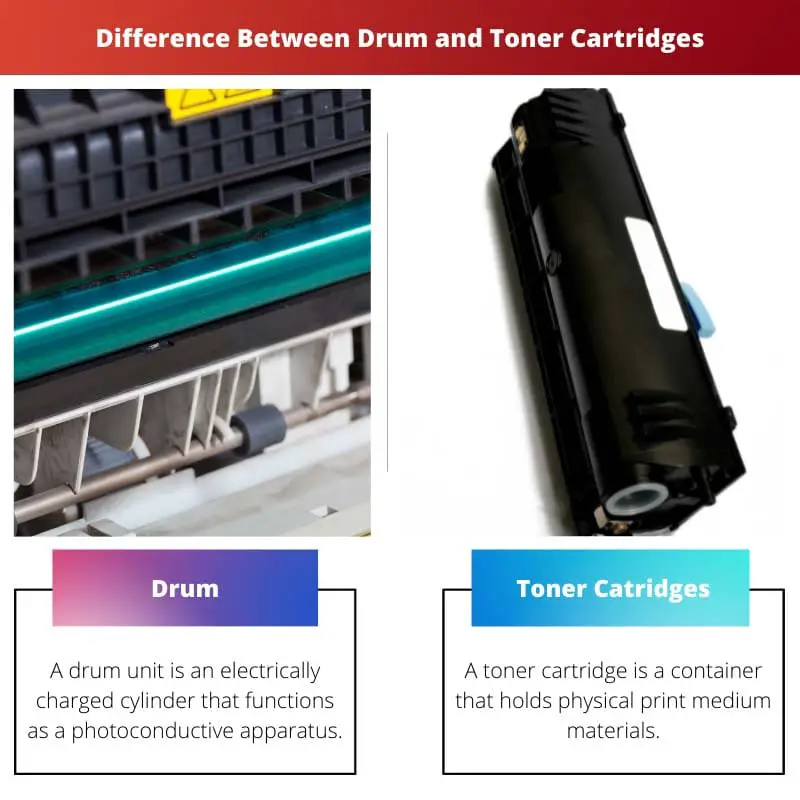Drum units and toner cartridges are two components of laser printers that in fact make the process of printing possible. However, laser printers come in several variations with different architectures.
While some combine the two parts into one whole element, others use them separately. Nonetheless, knowing the difference between the two can help diagnose a problem in the machine when the printed result is just not right.
Key Takeaways
- Drum cartridges transfer images onto paper, while toner cartridges supply toner to create the image.
- Drum cartridges are expensive to replace, while toner cartridges are cheaper.
- Drum cartridges are only sometimes necessary for some printer models, while toner cartridges are essential.
Drum vs Toner Cartridges
Toner cartridge holds negatively charged toner particles that are combined with positively charged imprinted image particles to create graphics.Drum cartridges contain electrostatically charged drum units that attract toner particles and cause them to be transferred onto the paper during printing.

A drum unit functions as a photoconductive apparatus that transfers and paints a digital image onto the surface of the paper. As it is positively charged, it attracts negatively charged toner particles from the toner cartridge to carry out this process.
When the printed image or text on the paper is unclear or has strokes on it, there’s a problem in the drum unit.
A toner cartridge is a container that holds physical print medium materials. These are negatively charged toner particles that are essentially dry powder made from plastic particles, carbon, and other colouring agents.
This powder is attracted to the electrostatically charged drum unit, after which it is transferred onto a paper. When the printed image or text is too light, it is time to change the toner cartridge.
Comparison Table
| Parameters of Comparison | Drum | Toner Cartridges |
|---|---|---|
| Meaning | A drum unit is an electrically charged cylinder that functions as a photoconductive apparatus. | A toner cartridge is a container that holds physical print medium materials. |
| Function | Its function is to attract and transfer positively charged toner particles onto paper. | Its function is to hold negatively charged toner particles. |
| Constituents | It contains the image that is transferred via an electric charge. | It contains a dry powder that is made of plastic particles, carbon, and other colouring agents. |
| When to Change | When the printout is unclear or has strokes in it, the drum unit needs to be changed. | When the printouts come out too light, the toner cartridge must be changed. |
| Cost | Drum units are costlier than toner cartridges. | Toner cartridges are cheaper in comparison with drum units. |
What is Drum?
A drum unit is a cylinder inside a laser printer that holds a positive charge. It attracts negatively charged toner particles and transfers them onto the paper’s surface.
Texts or images are then printed out. If the resulting print is unclear and has strokes or lines on it, it means that the printer’s drum unit needs to be changed.
The electrostatic property of the drum unit can be procured using two different methods. The first method includes using a corona wire that has an electric current running through it.
The second method includes using a separately charged roller instead of a corona wire. This method is relatively newer and is gaining popularity among many laser printers of different companies.
When the drum unit has been charged, and the toner particles have made their way into the drum unit, a laser beam is sent out from the printer laser scanner.
This tiny beam draws patterns on the drum unit’s surface to form a text or image. The toner particles then cling to the surface of the drum while a drum cleaning blade wipes out the excess powder.
The next step involves transferring the toner particles on the drum surface onto paper. When this happens, the toner and paper are put into a fuser roller that finally binds both. As a result, the text or image comes out as a printout on paper.
What are Toner Cartridges?
A toner cartridge is a container that holds negatively charged toner particles, essentially the physical print medium material.
These particles are fine, dry powders made from plastic particles, carbon, and other colouring agents. They make up the actual image on the paper, either black and white or coloured.
The toner particles are attracted to the positively charged drum unit, where their electrostatic property changes. This is one reason why they can be fused onto the paper using heated rollers.
Some toner cartridges are made in such a way that the drum unit is incorporated into its design. This means that if one of the two faces a problem, they must be replaced together.
However, most printers have a design where the two components are separate. The toner cartridge costs much cheaper in such printers than the drum unit.
In most cases, the drum unit last three to four times longer than a toner cartridge does. Nonetheless, the cartridge must be changed when a printout comes to light, and the colour is not very visible.
An interesting aspect about this is that combined drum units and toner cartridges are not as sustainable or healthy for the environment.
After all, if the drum unit needs to be changed every time a cartridge runs out, massive unnecessary ‘drum unit waste’ is dumped into landfills.

Main Differences Between Drum and Toner Cartridges
- A drum unit is an electrically charged photoconductive apparatus, whereas a toner cartridge is a container that holds physical print medium materials.
- The function of a drum unit is to attract and transfer positively charged toner particles onto paper, whereas that of toner cartridges is to hold negatively charged toner particles.
- A drum unit contains the image that is transferred via electric charge, whereas a toner cartridge contains dry toner powder.
- A drum unit needs to be changed when the printout is unclear or has strokes on it, whereas a toner cartridge needs to be changed when the printouts are coming out too light.
- Drum units are expensive, whereas toner cartridges are comparatively cheaper.


The article effectively highlights the differences between drum and toner cartridges, making it easier for readers to comprehend the unique functions of each component.
Absolutely, the detailed breakdown of the functionalities of drum and toner cartridges is highly informative and beneficial for anyone working with laser printers.
This article provides comprehensive information about drum and toner cartridges. It’s enlightening to understand the differences and functions of these components in laser printers.
Absolutely, the detailed explanation of the printing process and the differences between drum and toner cartridges is very informative.
The comparison table in this article succinctly outlines the key differences between drum and toner cartridges. It’s a great quick reference for anyone looking to understand these components better.
The cost comparison between drum units and toner cartridges is eye-opening. It’s interesting to note that toner cartridges are more affordable than drum units in the long run.
Definitely, the cost factor is an important consideration when it comes to choosing and maintaining laser printers.
The environmental impact of using combined drum units and toner cartridges is concerning. This article sheds light on the sustainability issue associated with these printing components.
I agree, the detrimental impact on the environment due to excessive ‘drum unit waste’ is an important point to consider when choosing printers and cartridges.
The detailed explanation of how a drum unit works to transfer images onto paper is fascinating. It’s impressive to learn about the intricate process behind laser printing.
Absolutely, the technical details provided in the article are truly fascinating and provide a deeper understanding of the printing process.
While the article provides valuable information about drum and toner cartridges, it would be beneficial to include more insight into the technological advancements in these components and their impact on printing quality.
I agree, an exploration of the latest technological developments in drum and toner cartridges would enhance the depth of this informative article.
The explanation of how toner cartridges work in the printing process is well-articulated and provides a clear understanding of their essential role.